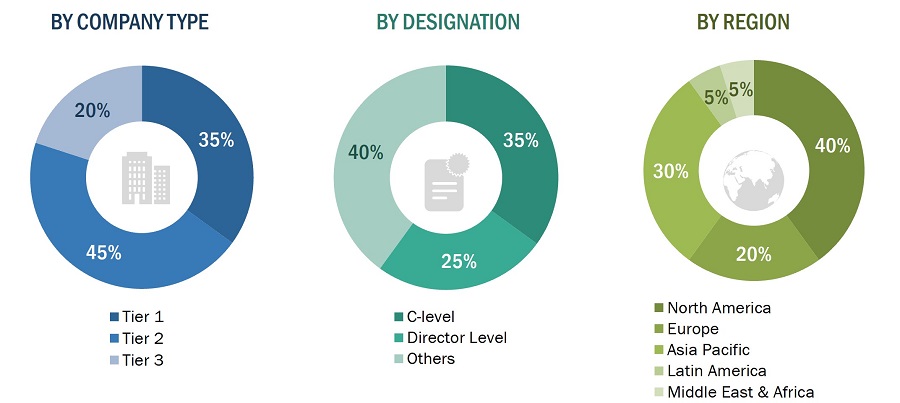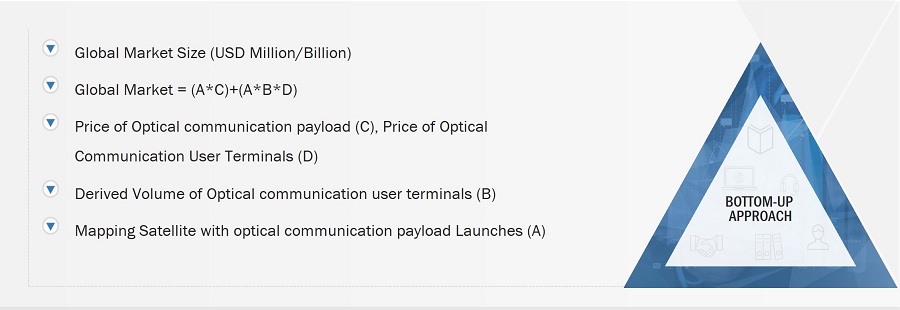The study involved four major activities in estimating the current size of the Optical satellite communication Market. Exhaustive secondary research was done to collect information on the Optical satellite communication market, its adjacent markets, and its parent market. The next step was to validate these findings, assumptions, and sizing with industry experts across the value chain through primary research. Demand-side analyses were carried out to estimate the overall size of the market. After that, market breakdown and data triangulation procedures were used to estimate the sizes of different segments and subsegments of the Optical satellite communication Market.
Secondary Research
The market ranking of companies was determined using secondary data made available through paid and unpaid sources and by analyzing the product portfolios of major companies. These companies the performance on the basis of the performance and quality of their products. These data points were further validated by primary sources.
Secondary sources referred to for this research study included financial statements of companies offering Optical Satellite Communication hardware and information from various trade, business, and professional associations. The secondary data was collected and analyzed to arrive at the overall size of the Optical Satellite Communication market, which was validated by primary respondents.
Primary Research
Extensive primary research was conducted after acquiring information regarding the Optical Satellite Communication market scenario through secondary research. Several primary interviews were conducted with market experts from both the demand and supply sides across major countries of North America, Europe, Asia Pacific, ROW which includes the Middle East & Africa, and Latin America. Primary data was collected through questionnaires, emails, and telephonic interviews.

To know about the assumptions considered for the study, download the pdf brochure
Market Size Estimation
The market sizing of the market was undertaken from the demand side. The market was upsized at a regional level based on procurements and modernizations in the land fixed, land mobile, airborne, naval, and portable platforms. Such procurements provide information on each platform's demand aspects of Optical satellite communication products. For each platform, all possible application areas where Optical satellite communication is integrated or installed were mapped.
Note: An analysis of technological, military funding, year-on-year launches, and operational cost were carried out to arrive at the CAGR and understand the market dynamics of all countries in the report. The market share for all type, component, application, and laser type was based on the recent and upcoming launches of Optical satellite communication products in every country from 2020 to 2028.
Optical satellite communication Market Size: Bottom-up Approach

Optical satellite communication Market Size: Top-Down Approach

Data Triangulation
After arriving at the overall size from the market size estimation process explained above, the total market was split into several segments and subsegments. The data triangulation and market breakdown procedures explained below were implemented, wherever applicable, to complete the overall market engineering process and arrive at the exact statistics for various market segments and subsegments. The data was triangulated by studying various factors and trends from both the demand and supply sides. Along with this, the market size was validated using both the top-down and bottom-up approaches.
The following figure indicates the market breakdown structure and the data triangulation procedure that was implemented in the market engineering process to make this report on the Optical Satellite Communication market.
Market Definition
The optical satellite communication market refers to the sector that deals with developing, manufacturing, and deploying satellite communication systems that utilize optical technology for data transmission. Optical satellite communication (free-space optical communication (FSO) involves sending data through laser beams or infrared signals instead of traditional radio frequency (RF) signals used in most satellite communication systems. This technology offers high data transmission rates, low latency, and increased security for sensitive data transfer. With a growing demand for global connectivity and data-intensive applications, optical communication presents a potential solution to meet these needs. Despite challenges related to atmospheric conditions, advancements in technology are continuously improving its viability.
Optical Satellite communication consists of Satellite-To-Satellite Communication Payloads: Satellite-to-satellite communication payload encompasses inter-satellite links (ISLs) deployed within satellites to facilitate optical communication between these spaceborne platforms.
Ground -To- Satellite- Communication Terminals: Ground-to-satellite communication terminals encompass optical ground terminals, including optical ground stations and optical terminals, employed for laser communication between the terrestrial infrastructure and satellite systems.
Market Stakeholders
-
Manufacturers of Optical satellite
-
System Integrators
-
Original Equipment Manufacturers (OEM)
-
Service Providers
-
Research Organizations
-
Investors and Venture Capitalists
-
Ministries of Defense
Report Objectives
-
To define, describe, and forecast the size of the Optical satellite communication market based on type, component, application, laser type, and region.
-
To indicate the size of the various segments of the Optical satellite communication market based on five regions North America, Europe, Asia Pacific, Rest of the world along with key countries in each of these regions.
-
To identify and analyze key drivers, restraints, opportunities, and challenges influencing the growth of the market.
-
To determine industry trends, market trends, and technology trends prevailing in the market
-
To analyze micro markets concerning individual technological trends, prospects, and their contribution to the overall market
-
To provide a detailed competitive landscape of the market and analyze competitive growth strategies such as product launches and developments, contracts, partnerships, agreements, and collaborations adopted by key players in the market.
-
To identify the detailed financial positions, product portfolios, and key developments of leading companies in the market
-
To strategically profile key market players and comprehensively analyze their market rank analysis and core competencies.
Available Customizations
MarketsandMarkets offers the following customizations for this market report:
-
Additional country-level analysis of the Optical satellite communication Market
-
Profiling of other market players (up to 5)
Product Analysis
-
Product matrix, which provides a detailed comparison of the product portfolio of each company in the Optical satellite communication Market.



Growth opportunities and latent adjacency in Optical Satellite Communication Market